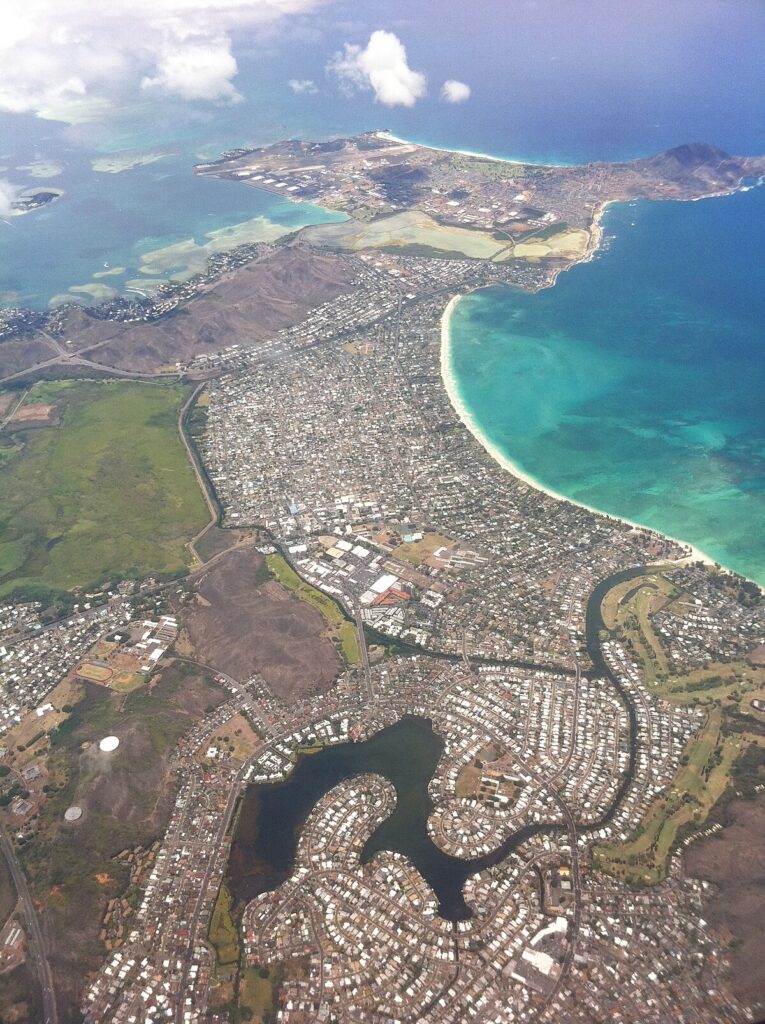
Moving to Kailua, Hawaii: A Comprehensive Relocation Guide
Considering moving to Kailua, Hawaii? This upscale Oahu community offers pristine beaches, small-town character, and island lifestyle. With approximately 39,000 residents in 2025, Kailua combines beach town atmosphere with excellent amenities and Oahu’s premier residential destination.
Demographic Profile to Consider If Moving to Kailua:
Kailua’s 2025 population is approximately 39,000 residents in this windward Oahu community on the eastern shore. The median age is around 42 years, with affluent families, military personnel, professionals, and retirees. The population is approximately 45% Asian, 30% White, 15% Two or More Races, 7% Native Hawaiian and Pacific Islander, 2% Hispanic. Kailua features world-famous Kailua Beach and Lanikai Beach, charming downtown with local shops and restaurants, upscale neighborhoods, and Marine Corps Base Hawaii (Kaneohe Bay) influencing the area. The community maintains beach town character while attracting affluent residents. Kailua appeals to military families, successful professionals, and those seeking Oahu’s most desirable beach community. The area values preservation, beach lifestyle, small-town atmosphere, and resisting overdevelopment. Find trusted local services for moving, living, and working in Kailua.Kailua Relocation Directory
Cost of Living to Consider If Moving to Kailua:
Kailua represents ultra-premium pricing for Oahu. Median home values range from $1.1 million to $2 million+ in 2025, with beachfront properties commanding significantly more. The median household income exceeds $120,000. Rental properties average $3,000 to $5,500+ monthly. Hawaii has high excise tax (4.5%). Overall cost of living is extremely high even by Hawaii standards. Kailua attracts military families (BAH supports some), wealthy professionals, and affluent retirees willing to pay premium for Hawaii’s premier beach community. Housing costs create significant exclusivity. The combination of pristine beaches, excellent schools, and small-town character justifies extreme pricing. Military presence provides some housing options on-base or with BAH support.
Economy and Job Market:
Kailua residents typically work at Marine Corps Base Hawaii, commute to Honolulu, or own businesses. MCBH Kaneohe Bay provides significant military employment. Many residents are retirees, military families, or professionals commuting over the Pali Highway to Honolulu jobs. Downtown Kailua supports local businesses, restaurants, and shops. Some residents work remotely. The broader Oahu economy offers opportunities though commutes can be lengthy. Typical commute times to Honolulu range 30-50 minutes over scenic but congested Pali Highway. Many military families choose Kailua for proximity to base and beaches. The affluent population supports high-end services and businesses.
Education:
Hawaii Department of Education operates Kailua schools including Kailua High School with schools generally rating well for public schools. Private schools serve families willing to pay tuition. The educational infrastructure benefits from the affluent population and military families’ advocacy. Schools serve diverse student body including military-connected children.
Recreation and Lifestyle:
Kailua offers world-class beaches with Kailua Beach Park (consistently ranked among America’s best beaches) featuring turquoise waters, white sand, and water sports. Lanikai Beach (adjacent) provides postcard-perfect scenery with Mokulua Islands offshore. Residents enjoy stand-up paddleboarding, kayaking to the Mokes (Mokulua Islands), surfing, and beach activities year-round. Downtown Kailua features local shops, restaurants, farmers market, and Whole Foods. Residents bike, walk, and embrace beach town lifestyle. Nearby hiking includes Lanikai Pillbox Trail with panoramic views. The lifestyle emphasizes beach living, outdoor activities, water sports, and small-town community. The trade winds create ideal weather year-round. The community fiercely protects beach access and opposes development threatening character. Living in Kailua means extreme costs, tourist day-trippers crowding beaches, and committing to premium pricing for Hawaii’s most perfect beaches and small-town atmosphere rare on crowded Oahu.
Healthcare and Services:
Kailua residents access healthcare through Castle Medical Center and clinics in Kailua. Military families access Naval Hospital at MCBH. Additional care is available in Honolulu when needed. The healthcare infrastructure serves the windward community.
Transportation:
Kailua is accessed via Pali Highway and Likelike Highway connecting to Honolulu over the Koolau Mountains. TheBus operates routes to Honolulu. Most residents use personal vehicles. Gas is very expensive. Downtown Kailua offers walkability. Beach areas accessible by bike. Typical commute times to Honolulu range 30-50 minutes depending on traffic over mountain passes.
Conclusion:
Moving to Kailua in 2025 offers premier beach living with world-class shores, small-town character, and island paradise. The community’s combination of Kailua Beach perfection, charming downtown, and residential atmosphere makes it ideal for affluent families, military personnel, and beach lovers seeking Oahu’s ultimate destination where turquoise waters meet white sand and extreme costs buy life in Hawaii’s most perfect beach town on the windward shore.

